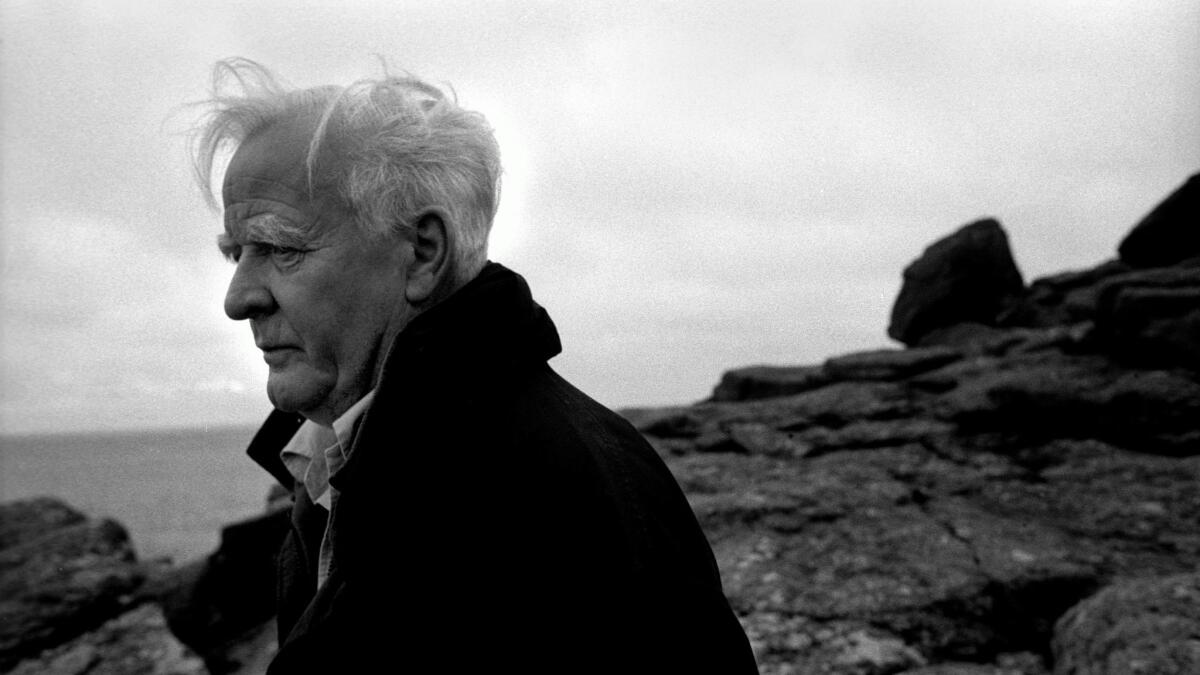John le Carré is back in fine form — with George Smiley — in ‘A Legacy of Spies’

- Share via
Our understanding of espionage was forever changed in the 1960s with the arrival of George Smiley, John le Carré’s “breathtakingly ordinary” spy who toiled at MI6, a.k.a. “the Circus,” Britain’s Secret Intelligence Service. It was a contrast to the espionage tales of author Ian Fleming, whose novels centered on James Bond’s dark, cruel good looks, his sexual escapades and a clear-cut demarcation of Good versus Evil, the British “us” versus the Soviet “them.”
Le Carré’s novels weren’t notable just because his protagonist wasn’t handsome. What set Smiley and his colleagues apart was the moral ambiguity of their exploits, which often placed them at odds with their own consciences. This murky worldview, a byproduct of the high-stakes Cold War against Communism, influenced the fiction of many of Le Carré’s contemporaries. But Le Carré, now 85, remained the master and transcendent king of the genre, ferrying readers through several Smiley-led excursions into the mole-infested ranks of the Circus, most notably 1963’s “The Spy Who Came in From the Cold” and 1974’s “Tinker Tailor Soldier Spy.”
But with the fall of the Berlin Wall and Russian glasnost, it was time for Smiley to say goodbye. “Time you rang down the curtain on yesterday’s cold warrior,” Smiley tells a class of new recruits in “The Secret Pilgrim,” published in 1990. “The new time needs new people.”
Indeed, other spies have emerged in the quarter-century that’s followed — penned by Olen Steinhauer, Daniel Silva, even Le Carré himself — who engage in global espionage involving the Middle East, China, Africa and a post-perestroika Russia controlled by oligarchs and mobsters. In the process, Smiley and the Circus of yesteryear have been put out to pasture.
One of the principal pleasures of ‘A Legacy of Spies’ is watching the battle of words and ideas between the old and new agents of Her Majesty’s Secret Service.
Which is literally where we find Peter Guillam at the beginning of “A Legacy of Spies,” framed as his memoirs, in which he’s focusing on his role in a British deception operation code-named Windfall. One of Smiley’s most trusted lieutenants — he helped recruit Alec Leamas for an undercover operation in East Berlin in the 1960s and later assisted in uncovering the mole in the Circus in the 1970s — Guillam has retired to his family farm in Brittany.
Guillam’s early recollections of Windfall are intertwined with tales of his father’s secret bravery during World War II and his own recruitment as a spy for Britain, a seemingly fortuitous process he regards in retrospect with some skepticism. “Sometimes I wonder whether it is possible to be born secret,” he muses, “in the way people are born rich, or tall, or musical.”
At the Victorian eyesore of a building in Central London known as the Circus, Guillam fulfills “my first vision of myself as a secret warrior in my dead father’s image.” It’s also where he first encounters “tubby, bespectacled, permanently worried George Smiley,” who seems to offer himself as a father figure.
But in the present day there is trouble, and Smiley has decamped for parts unknown, leaving Guillam to face the music alone when he is summoned to MI6’s shockingly ostentatious new headquarters along the Thames.
During the Cold War, Leamas, the spy in East Berlin, and Liz Gold, the woman he loved, both died trying to climb over the Wall. Now, two descendants are threatening to sue MI6 over the wrongful deaths of their respective parents, an event totally plausible in our litigious times. The threat activates two latter-day MI6 bureaucrats, “Bunny” Butterfield, a legal adviser to the chief of MI6 and Laura, whose presence in Guillam’s interrogation is to provide “history.” But history they seek about Operation Windfall — how it was mounted and led, where it went wrong and what role Guillam played — is nowhere to be found. Dummy files on the operation, planted in the MI6 archives, paint a conveniently whitewashed picture, while the personnel records of Leamas and others are missing or heavily redacted. Now, to avoid embarrassing public exposure and litigation, Bunny and Laura must extract the truth from a reluctant Guillam, who has his own secrets to keep. But eventually Guillam leads the pair to one of Smiley’s safe houses, where an old-guard safe house keeper, retired agent Millie McCraig, has been paid from a secret slush fund to stand watch over the cache of files and memos related to Windfall.
Fans of Le Carré’s earlier fiction — or their various film incarnations — will feast at the historical banquet that is ‘A Legacy of Spies.’
One of the principal pleasures of “A Legacy of Spies” is watching the battle of words and ideas between the old and new agents of Her Majesty’s Secret Service. Guillam’s feints, misdirection and outright lies are well orchestrated, while Bunny and Laura’s probing questions and exploration of the files Guillam is forced to read and clarify trigger the older agent’s “night-time journey of the soul.” In the process, readers learn why and how the East German mole Leamas was sent to protect was recruited, how the Russian-controlled mole planted in MI6 wreaked even more havoc on the lives of innocents and agents than suspected and how Guillam lost his heart, romantically and for his calling as a spy.
While “A Legacy of Spies” could be considered a Smiley novel — perhaps his last — the paterfamilias of the Circus is absent until its final chapters. Instead, Guillam holds the stage and our attention in this compelling examination of the quest for an imperfect ideal and the judgment of the generations that follow. But in all such quests, the day of reckoning must come when the pupil challenges the master and the son vanquishes his father. In the old spies’ long-awaited confrontation, Guillam seeks answers from Smiley to the inscrutable questions of his life and career, namely: “How much of our human feeling can we dispense with in the name of freedom…before we cease to feel either human or free?”
Fans of Le Carré’s earlier fiction — or their various film incarnations — will feast at the historical banquet that is “A Legacy of Spies,” which serves almost as a prequel to the earlier novels. For new readers, the themes Le Carré explores — most notably the toll exacted on the individual’s soul by serving institutions that fail to live up to their professed values — will resonate as they consider past and present covert actions of British and U.S. governments. For as Smiley notes, quoting a Russian joke popular in the 1950s, “There will be no war, but in the struggle for peace not a stone will be left standing.”
Woods is a member of the National Book Critics Circle, an editor and author of the Charlotte Justice mystery series.
John le Carré
Viking: 272 pp., $28
More to Read
Sign up for our Book Club newsletter
Get the latest news, events and more from the Los Angeles Times Book Club, and help us get L.A. reading and talking.
You may occasionally receive promotional content from the Los Angeles Times.










